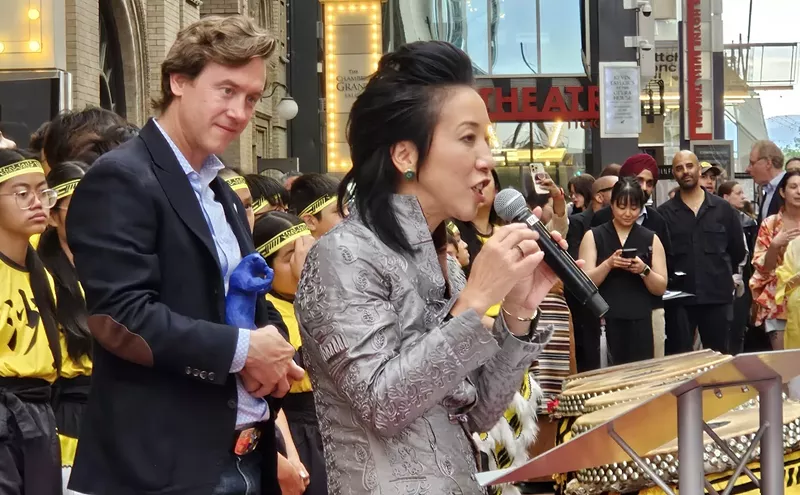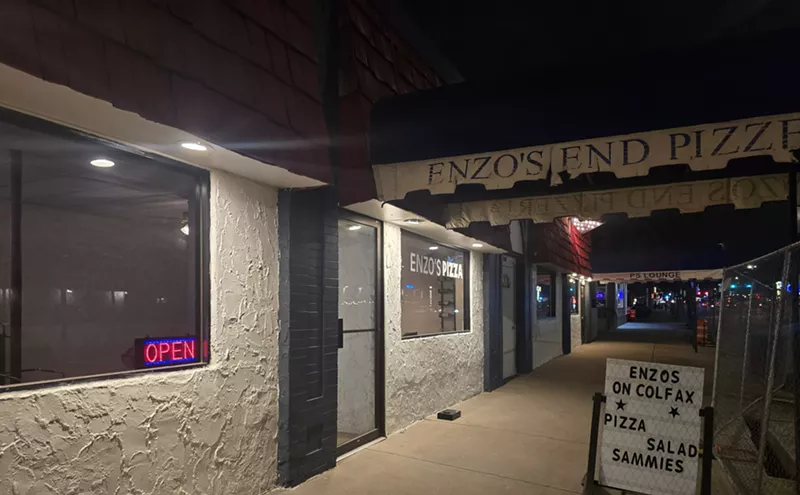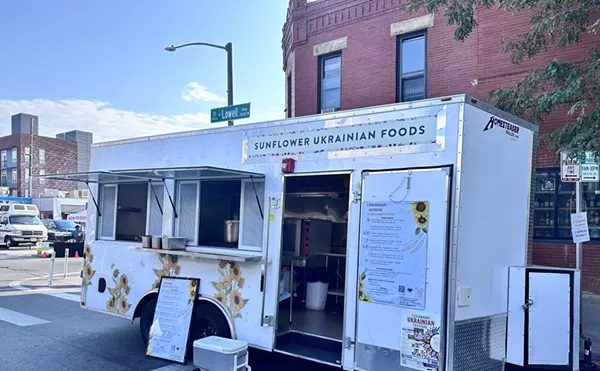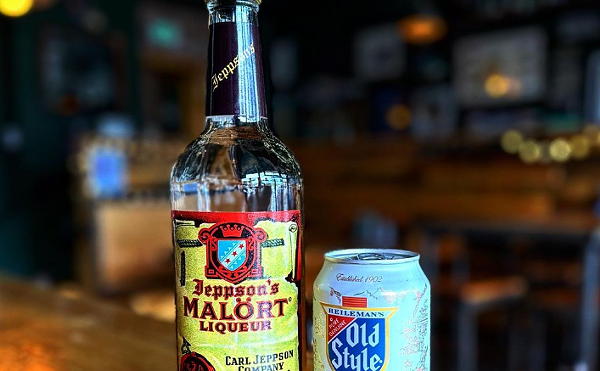For decades, Szechuan Chinese Restaurant has been doing business in one of the worst imaginable locations in all of restaurantdom, holding down a chunky, L-shaped space folded into the elbow of a nearly inaccessible strip mall off a one-way frontage road running beneath and beside a fast-moving stretch of Sixth Avenue in Lakewood. Driving along that busy highway, you glimpse the place for only half a second -- the gleam of neon, a Tsingtao beer sign, its name blinking between treetops and traffic -- and to get there, you have to pass it by, exit, backtrack past the high school and the jail, drive the wrong way along a one-way street for about two dozen feet and then find the blind entrance to the Meadowlark Plaza parking lot. There may be easier, less circuitous ways to get to Szechuan, but this is the only one I know. And I still get lost every time and have to reverse my way out, untangle myself from the maze of U-turns and access roads, start fresh.
Szechuan is flanked by a cluttered liquor store and a Family Dollar so brightly lit by bare white fluorescents that it seems to sizzle in the dark. There's a cabinet store, a breakfast bar, a coffee shop/bookstore where you can get your palm read or buy crystals to balance your chi, and a storefront where you can learn to speak Italian. After six o'clock, though, most of the parking lot is empty, with all the action concentrated down at the far end -- Szechuan's end. Peek through the smoked-glass windows filled with signs and menus and you'll see that inside, Szechuan is jumping.
It's not full -- I don't think I've ever seen the place completely full. But it's busy. It's almost always busy. Monday night at eight? Busy. Saturday at five? Busy. Super Bowl Sunday? Killer busy, with extra waitresses laid on, a non-stop parade of take-away going out the door, and a busser who'd go around to any table that was interested and give the current score, the count, yardage, and a brief rundown of who was looking good and who was fading. Although a small TV up front was tuned to the game, it was more fun to get the busser's tableside updates, complete with opinion and speculation and play-by-play. For those of us who cared, it was like having our own private color man working the room.
Fortunately, busy is enough for a place like this. I've spent too much time in little, lost neighborhood Chinese spots eating entirely alone. To me, there's no soundscape quite so grim as the scrape of a single spoon scooping the sauce out of the bottom of a single platter of kung pao chicken in an otherwise empty dining room, the rattle of a single chair scuffing the floor, or the constant squeak of a kitchen door opening and closing as the single waiter checks the floor, waiting for those customers who resolutely refuse to come. Conversely, I am perhaps inordinately pleased by the buzz of a room in use: the screaming children, the clatter of dropped silver, the shouts in Chinese from the back, the chatter of the table of six asking time after time after time for more white rice, more white rice, more white rice. In a place like this, I can relax. I can take my time reading the menu and not feel bad about demanding a couple extra minutes to internally debate spare ribs or sliced pork, hot garlic tofu versus two kinds of meat. At Szechuan, my server will just nod and move on to the next table, then the next, and eventually work her way back around to me.
Still, with its terrible, invisible location and all the other Chinese choices around town -- the Cantonese and Mandarin and Szechuan options, both Americanized and authentic, the dim sum restaurants and takeout joints, the peasant food and party food -- how does Szechuan manage to stay busy?
Time and patience play a big part. Szechuan has been operating in this location seven days a week for close to thirty years, and over that period, it's built up a dedicated crowd of regulars. Tradition is important, too: Szechuan was one of the first serious sit-down Chinese restaurants to open in the western suburbs, and one of the first serious Szechuan restaurants to open anywhere in Denver. The service is friendly, quick and accommodating. The menu is huge, with well over a hundred options, not counting lunch (which adds another 75 plates to the mix). The prices are low (topping out under twelve bucks), the portions are big and the flavors fresh.
But really, there's just one reason Szechuan stays so busy: the dumplings. This kitchen makes the best dumplings I've eaten in Colorado, the best I've found anywhere in the Southwest, maybe the best between Chicago and the California border. And I'm a man who takes his dumplings very, very seriously. I've eaten a lot of them. Dumplings from the East and dumplings from the West, American and Asian and Russian and European dumplings, classical dumplings and awful, terrible fusiony dumplings, and dumplings that are only dumplings by the loosest of all possible definitions. I have long said that while the human race has plenty that divides us, dumplings are one of those rare things that unite us all. I am hard-pressed to think of a single culture or country that does not have a dumpling recipe of some kind somewhere in its traditional canon. From American low-country cookpots to the heights of Everest, dumplings are everywhere.
And at Szechuan, the Chinese dumpling -- that most recognizable international dumpling iteration -- has been brought to a pinnacle. This kitchen makes the dumplings huge, as big across as a balled fist, and heavy. The dough is just the right thickness, neither flimsy like Italian tortelloni or Japanese seafood-soup dumplings nor thick like Russian pelmeni. The filling is pork and ginger and herbs, assembled by hand, worked with the fingers like a great meatloaf so that it is dense without being heavy, and solid -- not ethereal, not fluffy, not aerated like the fillings of those nouvelle monstrosities made to taste like fish marshmallows or clouds of pork. And whether pan-fried (on one side only, until browned but not quite crisp) or steamed (soft but not limp, yielding but not gooey), they are always cooked perfectly: al dente, to borrow from the Italians, ideally textured and never over- or underdone. I can say "always" with some confidence, because I have eaten more than a hundred of them.
The dumplings are served eight to an order, with a sweet and salty soy sauce sharpened by tiny flakes of red chile. A single plate is a meal in itself -- satisfying on a level that, after half the dish has been eaten, no longer has anything to do with simple hunger, but everything to do with the pampering comfort of salt and grease and the work of skilled hands. The regulars here know this; just about every occupied table holds a plain white dumpling plate, empty but for some dabs of oil and spatters of soy, pushed off to one corner with the teapot and rice bowl to make room for everything else beyond the dumplings that Szechuan does so well.
The plethora of vegetable and tofu dishes are prepared with a surprisingly light hand and dressed with a kind of modernity that isn't actually modern but has come back into vogue with the sudden glut of Asian-American vegetarian restaurants opening across the country. You could fly to New York City or San Francisco, where all things tofu have unexpectedly become popular again, be seated next to a table of starving, dumb socialites who insist on pronouncing tofu as two words ("to fu," accent on the fu) and get these same dishes for forty bucks a throw. Or you can stop by Szechuan and pay no more than seven bucks for sesame tofu, for ma po tofu tossed in a fiery chile sauce, for eggplant mixed with fresh mushrooms, or a blissfully simple plate of snow peas, water chestnuts and mixed mushrooms all flash-sautéed together in the pan.
Soup here is a meal, served not by the pint or quart, but according to how many spoons will be sharing the bowl. The won ton is traditional, the egg drop salty and thick, the sizzling-rice varieties (essentially broth soups with a mirepoix of snow pea, carrot, celery and squash, topped at the last minute with a handful of Rice Krispies) delicious six nights out of seven, but occasionally too weak to stand up to all the dried rice. The sweet-and-sour options are never very impressive, the meat (chicken or shrimp) battered and fried in the customary way and covered with a sauce that tastes like pineapple juice, melted penny candy, maple syrup and Liquid Smoke all poured together into an old rum shaker and kicked repeatedly around the kitchen. But then, this is a Szechuan restaurant (its name is a good clue), and the sweet-and-sour quadrants of the flavor spectrum are not something that Szechuan cooks have ever done particularly well. Spicy is their thing, and they know how to work with chile peppers and peppercorns and pickled vegetables and anything else that will light a mouth on fire in hopes of making you forget the heat and humidity of Western China in the hot months.
On countless nights, I have sat in the sparsely decorated but comfortable and well-broken-in back dining room eating Royal this and Happy that, menu titles that connote pleasure but don't actually describe whence this pleasure might spring. Happy anything, I have found, means that there will be a lot of that anything. And Royal anything (except Royal wonton, which translates to simply delicious) means served over pan-fried noodles in a great mound with brown sauce that will immediately drip to the bottom of the serving platter. Once when we were trying to negotiate our way through the Royal chicken -- prying apart layers of fried round noodles, sawing through those that connected our plates to the platter and doggedly refused to let go -- the hostess spotted us and fairly sprinted to our table, where she took the serving utensils right out of Laura's hands and tossed the platter so that the tough noodles, those not yet softened by the sauce, ended up at the bottom and the already soaked noodles came out on top, ready to eat. She moved to hand the spoon and serving fork back, hesitated, thought better of it, and then just served us both herself, smiling and laughing the whole time.
I haven't yet tried the duck dishes here, but I will. Someday. I haven't yet figured out the difference between sesame chicken and new sesame chicken (they both cost the same on the menu). And I've purposely avoided the pu pu platters because I've become skittish about any presentation involving a miniature Sterno-fired barbecue grill -- a sure sign of a dish made more for visual effect than taste. But on my last visit, I finally got around to ordering the salt-and-pepper shrimp, which were fantastic -- lightly battered in a salt-and-pepper-heavy mix, then fried quickly and salted again before service. The beef with snow peas was also great, partly because this kitchen (unlike most Chinese restaurant kitchens I've encountered) slices its beef very thick and cooks it very fast. In flavor and texture, it compares to fondue beef -- quickly fried in boiling oil, then removed while still tender -- done in lovely, sticky bean sauces and brown sauces and curry sauces calibrated for allowing the flavor of the meat to shine through.
Next week or the week after, I'll be back. After getting lost again. But what you find when you finally arrive at Szechuan overcomes any obstacle. The dumplings alone are worth the drive.












